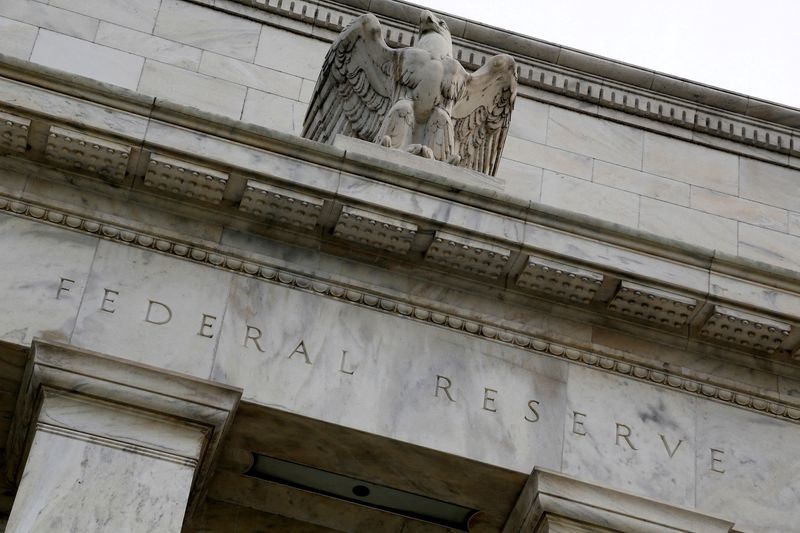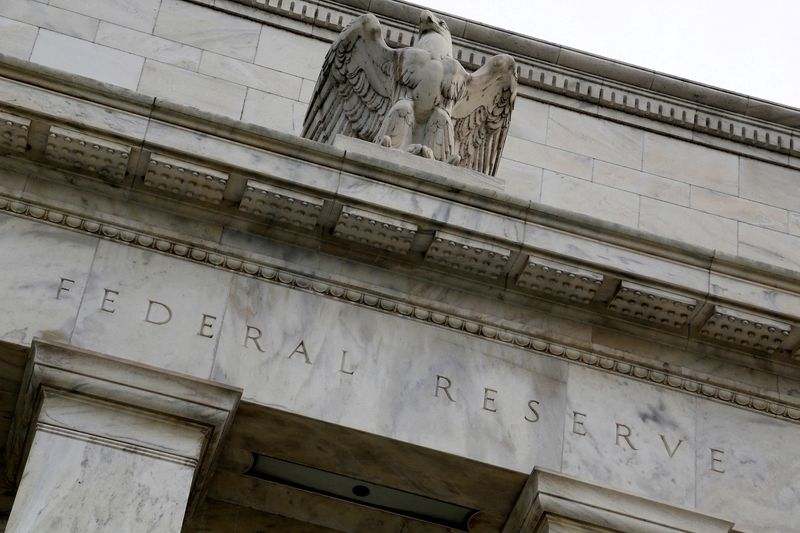Economy
US banks face more fair lending scrutiny under new regulations


© Reuters. FILE PHOTO: An eagle tops the U.S. Federal Reserve building’s facade in Washington, July 31, 2013. REUTERS/Jonathan Ernst/File Photo
By Pete Schroeder
WASHINGTON (Reuters) – U.S. regulators will begin grading banks on which communities and geographies they service via online lending under tougher new rules modernizing fair lending standards to be finalized on Tuesday.
The changes to 1977 Community Reinvestment Act (CRA) regulations draw a line under a contentious multiyear effort that was delayed amid fierce lobbying by community groups and lenders, as well as by a change of presidential administrations.
They broaden the geographies in which lenders will be required to extend loans and other services to low-income Americans, making it tougher for banks to receive top marks when being graded for CRA compliance.
Conceived to prevent red lining, CRA regulations are central to banks’ overall supervisory performance. Poor CRA grades put lenders in a so-called penalty box, meaning they are barred from doing mergers and other deals.
“The final rule takes a critical step forward in modernizing the CRA regulations to help ensure that banks meet the needs of all the communities they serve,” said Federal Reserve Vice Chair for Supervision Michael Barr in a statement.
The Fed approved the proposal Tuesday morning, but Fed Governor Michelle Bowman opposed it, calling it overreaching and overly complex. Two other regulators, the Federal Deposit Insurance Corporation and Office of the Comptroller of the Currency, were expected to finalize the rules later Tuesday.
Historically, CRA grades focused on how well banks serviced low-income communities where banks have branches. Banks will now also be graded on how well they service low-income communities in the areas in which they provide large numbers of mortgages and small business loans through online and mobile lending.
Agency officials said the final rule had been simplified to make higher grades more achievable, and that they had extended the implementation date, with most requirements effective in 2026.
“The final rule includes some revisions to the proposal that industry commenters had called for, but still expands the CRA into geographies and areas of focus that have never been covered before,” said bank regulatory partner Randy Benjenk at law firm Covington & Burling.
The updated rules also attempt to provide a more consistent process for grading banks’ performance, after the industry complained the prior regime could be opaque and subjective.
Now, regulators will provide a list of the types of activities for which banks can receive credit under the CRA grading system, and allow them to seek feedback on whether an activity would count.
Banks on Tuesday said they supported fair lending but flagged concerns with the final rule.
“We urge regulators to take a hard look at compliance burdens that could lead to reduced lending and to extend the implementation time frame, given the significant time and resources required for banks to comply with a complex new rule,” said Lindsey Johnson, head of the Consumer Bankers Association.
Economy
Russian central bank says it needs months to make sure CPI falling before rate cuts -RBC


© Reuters. Russian Central Bank Governor Elvira Nabiullina attends a news conference in Moscow, Russia June 14, 2019. REUTERS/Shamil Zhumatov/File Photo
MOSCOW (Reuters) – Russia’s central bank will need two to three months to make sure that inflation is steadily declining before taking any decision on interest rate cuts, the bank’s governor Elvira Nabiullina told RBC media on Sunday.
The central bank raised its key interest rate by 100 basis points to 16% earlier in December, hiking for the fifth consecutive meeting in response to stubborn inflation, and suggested that its tightening cycle was nearly over.
Nabiullina said it was not yet clear when exactly the regulator would start cutting rates, however.
“We really need to make sure that inflation is steadily decreasing, that these are not one-off factors that can affect the rate of price growth in a particular month,” she said.
Nabiullina said the bank was taking into account a wide range of indicators but primarily those that “characterize the stability of inflation”.
“This will take two or three months or more – it depends on how much the wide range of indicators that characterize sustainable inflation declines,” she said.
The bank will next convene to set its benchmark rate on Feb. 16.
The governor also said the bank should have started monetary policy tightening earlier than in July, when it embarked on the rate-hiking cycle.
Economy
China identifies second set of projects in $140 billion spending plan


© Reuters. FILE PHOTO: Workers walk past an under-construction area with completed office towers in the background, in Shenzhen’s Qianhai new district, Guangdong province, China August 25, 2023. REUTERS/David Kirton/File Photo
SHANGHAI (Reuters) – China’s top planning body said on Saturday it had identified a second batch of public investment projects, including flood control and disaster relief programmes, under a bond issuance and investment plan announced in October to boost the economy.
With the latest tranche, China has now earmarked more than 800 billion yuan of its 1 trillion yuan ($140 billion) in additional government bond issuance in the fourth quarter, as it focuses on fiscal steps to shore up the flagging economy.
The National Development and Reform Commission (NDRC) said in a statement on Saturday it had identified 9,600 projects with planned investment of more than 560 billion yuan.
China’s economy, the world’s second largest, is struggling to regain its footing post-COVID-19 as policymakers grapple with tepid consumer demand, weak exports, falling foreign investment and a deepening real estate crisis.
The 1 trillion yuan in additional bond issuance will widen China’s 2023 budget deficit ratio to around 3.8 percent from 3 percent, the state-run Xinhua news agency has said.
“Construction of the projects will improve China’s flood control system, emergency response mechanism and disaster relief capabilities, and better protect people’s lives and property, so it is very significant,” the NDRC said.
The agency said it will coordinate with other government bodies to make sure that funds are allocated speedily for investment and that high standards of quality are maintained in project construction.
($1 = 7.1315 renminbi)
Economy
Russian central bank says it needs months to make sure CPI falling before rate cuts -RBC


© Reuters. Russian Central Bank Governor Elvira Nabiullina attends a news conference in Moscow, Russia June 14, 2019. REUTERS/Shamil Zhumatov/File Photo
MOSCOW (Reuters) – Russia’s central bank will need two to three months to make sure that inflation is steadily declining before taking any decision on interest rate cuts, the bank’s governor Elvira Nabiullina told RBC media on Sunday.
The central bank raised its key interest rate by 100 basis points to 16% earlier in December, hiking for the fifth consecutive meeting in response to stubborn inflation, and suggested that its tightening cycle was nearly over.
Nabiullina said it was not yet clear when exactly the regulator would start cutting rates, however.
“We really need to make sure that inflation is steadily decreasing, that these are not one-off factors that can affect the rate of price growth in a particular month,” she said.
Nabiullina said the bank was taking into account a wide range of indicators but primarily those that “characterize the stability of inflation”.
“This will take two or three months or more – it depends on how much the wide range of indicators that characterize sustainable inflation declines,” she said.
The bank will next convene to set its benchmark rate on Feb. 16.
The governor also said the bank should have started monetary policy tightening earlier than in July, when it embarked on the rate-hiking cycle.

 Forex2 years ago
Forex2 years agoForex Today: the dollar is gaining strength amid gloomy sentiment at the start of the Fed’s week

 Forex2 years ago
Forex2 years agoHow is the Australian dollar doing today?

 Forex1 year ago
Forex1 year agoUnbiased review of Pocket Option broker

 Forex2 years ago
Forex2 years agoDollar to pound sterling exchange rate today: Pound plummeted to its lowest since 1985

 Cryptocurrency2 years ago
Cryptocurrency2 years agoWhat happened in the crypto market – current events today

 World2 years ago
World2 years agoWhy are modern video games an art form?

 Stock Markets2 years ago
Stock Markets2 years agoMorgan Stanley: bear market rally to continue

 Economy2 years ago
Economy2 years agoCrude oil tankers double in price due to EU anti-Russian sanctions

































